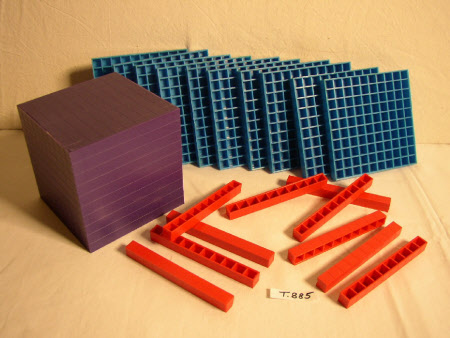Base 10
Category
Education objects
Date
circa 1982
Materials
Plastic and cardboard
Measurements
Box - 282 mm (length); 125 mm (width); 112 mm (height), Cube - 100 mm (length); 100 mm (width); 100 mm (height), Each flat piece - 100 mm (length); 100 mm (width); 10 mm (height), Each long piece - 100 mm (length); 10 mm (width)
Order this imageCollection
Sudbury Hall Museum of Childhood, Derbyshire
NT 664732
Summary
A set of plastic mathematical teaching aids known as Base 10 'Dienes Blocks' (manufacturer unknown) and supplied by Nottingham Educational Supplies. This set consists of ten blue squares known as 'flats' which have ten small embossed squares to each side. A rectangular cardboard box with a removable lid which is possibly the original box. There are ten red rods known as 'longs', each ten embossed squares long and one square wide, and one purple 'cube', ten embossed squares wide, long and high. The name of Zoltan P. Dienes (1916 - 2014) stands with those of Jean Piaget and Jerome Bruner as a legendary figure whose theories of learning have left a lasting impression on the field of mathematics education. Dienes' name is synonymous with the Multi-base blocks (also known as Dienes blocks) which he invented for the teaching of place value. He also is the inventor of Algebraic materials and logic blocks, which sowed the seeds of contemporary uses of manipulative materials in mathematics instruction. Dienes' place is unique in the field of mathematics education because of his theories on how mathematical structures can be taught from the early grades onwards using multiple embodiments through manipulatives, games, stories and dance. Total number of items is 21.
